Mapping the Hidden: A Journey into Ground Penetrating Radar

GPR is a robust non-destructive method employed to explore what lies below the surface without needing the requirement for disruptive drilling or excavation. This cutting-edge technology makes use of radar pulses to visualize the subsurface, allowing for a comprehensive examination of geological structures, utilities, and even archaeological artifacts. As the requirement for precise subsurface information continues to grow, GPR surveys have become indispensable tools across various industries, from construction and engineering to environmental studies.

Understanding GPR and its applications is important for professionals tasked with designing and executing projects that rely on accurate underground data. Whether you are an design engineer determining ground conditions, a contractor assessing site feasibility, or a landowner interested about subsurface features, this article will guide you through the fundamental aspects of GPR surveys. We will discuss how this technology works, the advantages it offers, and its wide-ranging applications, arming you with the understanding to leverage GPR effectively in your next project.
Grasping Ground Penetrating Radar Tech
Ground Penetrating Radar is a nonintrusive geophysical method that uses electromagnetic waves to visualize and analyze the subsurface. The technology functions by sending out quick pulses of radio waves into the ground. When these waves meet various substrates, such as soil, rock, or buried utilities, they reflect back to the surface. By analyzing these echoes, GPR can construct detailed images of subsurface characteristics, making it an crucial tool for a diverse array of uses.
The tools used in GPR studies typically consists of a sending unit and receiver antenna, which can vary in frequency. Lower-range frequencies go deeper into deeper but provide reduced resolution, while higher frequencies offer superior resolution but shallower depth. This versatility allows users to choose the appropriate configurations based on the specific needs of the survey, whether it's finding utilities, assessing geological features, or exploring historical sites. The information collected from GPR studies is usually shown in live, providing instant information into the subsurface characteristics.
GPR methods is advancing with enhancements in software and analysis methods that enhance data interpretation. Advancements such as three-dimensional mapping and integration with Geographic Information Systems (GIS) enable more comprehensive evaluation and visualization of subsurface conditions. As understanding of GPR methods grows, its uses expand, making it a key component in contemporary infrastructure projects, ecological evaluations, and archaeological investigations.
Advantages and Applications of GPR Investigations
GPR surveys offer many advantages, particularly in their ability to provide non-intrusive subsurface visualization. This technology can rapidly identify and map out subsurface utilities, voids, and earth features without the need for extensive excavation. By using EM waves, GPR can generate high-resolution pictures of different materials and structures beneath the surface, reducing interference on building sites and enhancing safety for staff.
The uses of GPR surveys are wide-ranging and varied, covering industries such as construction, historical research, and ecological studies. In building and engineering projects, GPR helps locate the location of utilities and building issues before digging begins, lowering the chance of harm and associated expenses. In archaeology, GPR can reveal hidden relics and buildings, allowing for meticulous excavation processes that protect cultural locations. Additionally, it has a crucial role in environmental and geotechnical investigations, helping experts evaluate earth composition and detect contamination.
Additionally, GPR surveys greatly aid to infrastructure inspections by enabling routine monitoring of highways, overpasses, and additional important assets. They assist in finding subsurface anomalies that could lead to infrastructure failures, thus facilitating prompt repairs. By offering a swift and cost-effective way to evaluate underground conditions, GPR surveys are becoming an essential tool in modern industry, promoting effectiveness and improved choices in facility development and management.
Ground Penetrating Radar Surveys in Construction and Engineering
Ground Penetrating Radar (GPR) surveys are emerging as an essential tool in the realm of construction and engineering. By utilizing GPR technology, professionals can quickly and without disruption identify the existence of subsurface utilities, geological anomalies, and possible dangers. browse around here is crucial for planning construction activities, maintaining safety, and reducing risks related to unforeseen underground conditions. With early detection of these elements, project schedules can be maintained, reducing hold-ups and unforeseen expenses.
In infrastructure development, GPR surveys assist engineers in assessing the stability of existing components and foundations. By finding GPR Survey Stourport-on-Severn , fissures, or other issues within concrete and below-surface layers, GPR provides insights that are vital for making informed decisions regarding repairs or strengthening. This forward-thinking method not only protects construction quality but also enhances the longevity of structures.
Additionally, GPR surveys contribute substantially to compliance with regulations and environmental evaluations. By charting underground conditions accurately, construction teams adhere to safety regulations and environmental guidelines, reducing the effects on surrounding environments. As the construction industry continues to embrace new technologies, GPR emerges as a reliable technique that enhances project productivity and sustainability, ultimately leading to more secure and more robust infrastructures.
